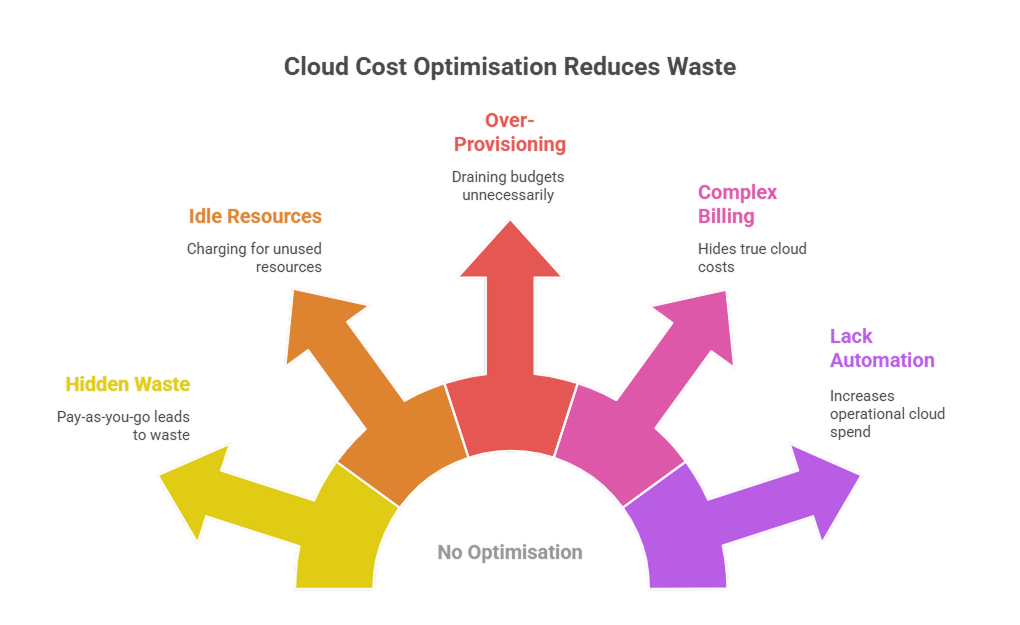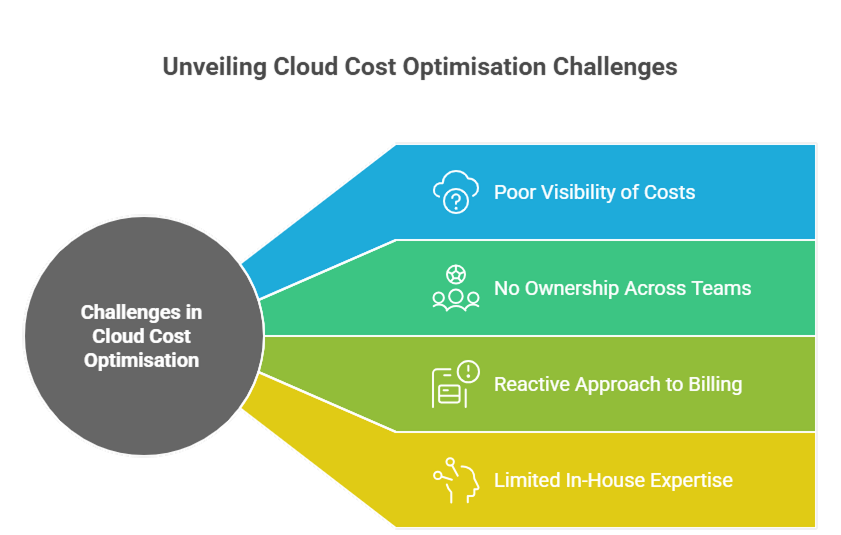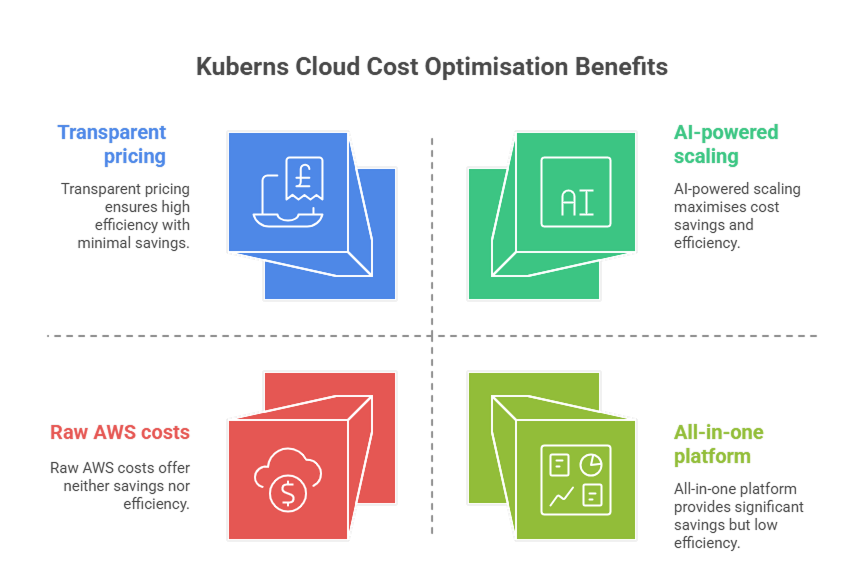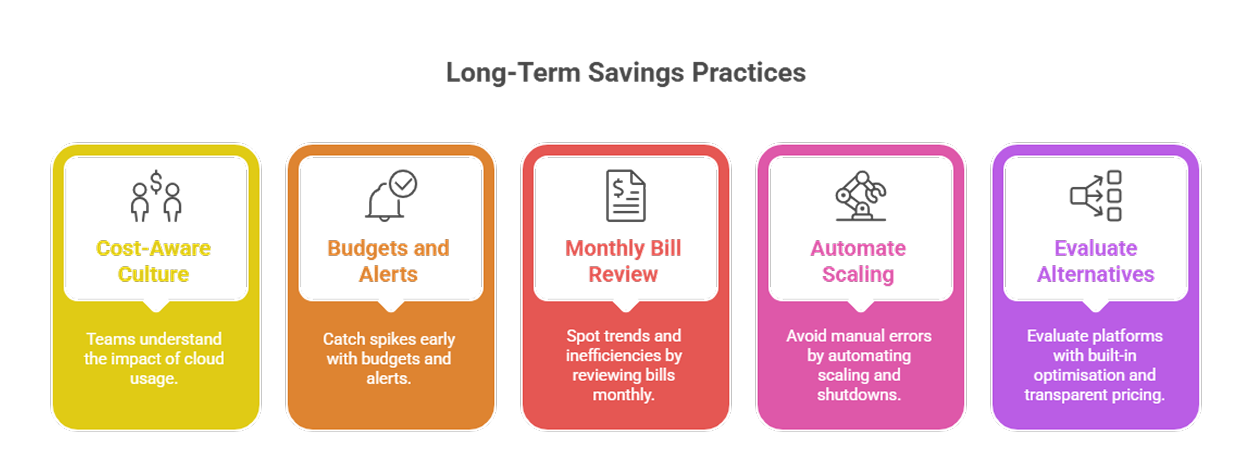Published
- 11 min read
Cloud Cost Optimisation: A Complete Guide for 2025

Key Highlights
- Cloud cost optimisation ensures resources are used efficiently and expenses stay predictable
- Common issues include idle servers, over-provisioning, and complex billing models
- Proven strategies include right-sizing, auto-scaling, storage optimisation, and automation
- AI-powered platforms like Kuberns deliver up to 40% cost savings with built-in optimisation
Introduction to Cloud Cost Optimisation
Cloud computing gives businesses the speed and flexibility to build and scale applications without heavy upfront infrastructure costs. The challenge is that cloud bills often rise quickly when resources are left idle, services are over-provisioned, or pricing models are unclear. Without the right approach, what looks cost-effective at first can become a financial burden.
This is where cloud cost optimisation comes in. It ensures every resource delivers value, keeps expenses predictable, and frees teams to focus on innovation. Platforms like Kuberns take this further by using AI to cut waste, prevent over-provisioning, and deliver up to 40% savings. To see how cost optimisation connects with building and scaling apps, explore our post on What Is Kuberns, The Simplest Way to Build, Deploy, and Scale Full-Stack Apps.
What Is Cloud Cost Optimisation?
Cloud cost optimisation is the discipline of making sure every unit of cloud spend delivers measurable business value. It goes beyond cutting costs, focusing on aligning usage with business outcomes, improving resource efficiency, and reducing waste. This includes right sizing compute and databases, scheduling non production environments to shut down when idle, applying auto scaling, using cost effective storage tiers, and reviewing workloads regularly to avoid hidden charges.
In simple terms, it is not only about spending less, it is about spending smarter. For a practical guide focused on AWS, read How to Reduce AWS Cost.
Why Cloud Cost Optimisation Matters
Cloud providers like AWS, Azure, and Google Cloud operate on a pay as you go model, which promises flexibility but often leads to hidden inefficiencies. Many businesses assume that this model automatically guarantees cost effectiveness, yet in reality, overspending is common.
 Some of the main reasons include:
Some of the main reasons include:
- Idle resources such as unused VMs, containers, or storage buckets that continue to generate charges
- Over-provisioning, where infrastructure is allocated far above actual workload requirements
- Complex billing structures with hundreds of SKUs and hidden charges that make true visibility difficult
- Limited automation, where resources are not scaled down during off-peak hours, leading to waste
Without a proper cost optimisation strategy, cloud bills can increase month after month, putting pressure on budgets. This is especially challenging for startups and SMBs that need predictable expenses and cannot afford to overspend.
To explore how modern approaches can solve these issues, read How AI Optimisation Makes IT Cloud Solutions Cost Effective.
Common Challenges in Cloud Cost Optimisation
 While most businesses recognise the need to optimise cloud costs, many run into similar challenges that make the process harder than expected:
While most businesses recognise the need to optimise cloud costs, many run into similar challenges that make the process harder than expected:
- Poor Visibility. Cloud bills often contain hundreds of line items, making it difficult to see which applications, teams, or environments are responsible for the bulk of expenses. Without clear cost allocation, it becomes almost impossible to make informed decisions.
- No Ownership. In many organisations, different teams spin up resources independently. When no single group is accountable for overall cloud spend, costs increase without governance or consistent policies in place.
- Reactive Approach. Companies often review costs only when they receive a surprisingly high bill. By that point, waste has already accumulated. A lack of continuous monitoring and alerts means optimisation happens too late.
- Limited Expertise. Effective cost management requires skills in DevOps, cloud architecture, and financial operations. Smaller businesses or startups may not have this expertise in-house, which leads to inefficiencies and reliance on trial and error.
These challenges highlight why cloud cost optimisation is not just about turning off unused resources, it requires structure, automation, and the right tools to gain control and achieve predictable savings.
Strategies for Effective Cloud Cost Optimisation
 Optimising cloud costs is not a one-time task, it is a continuous process that requires visibility, automation, and the right practices. Below are some of the most effective strategies businesses can apply today.
Optimising cloud costs is not a one-time task, it is a continuous process that requires visibility, automation, and the right practices. Below are some of the most effective strategies businesses can apply today.
1. Right-Sizing Resources
Many companies overestimate their needs and pay for oversized instances, databases, or storage volumes. By regularly analysing workloads and adjusting to actual usage, you can balance cost and performance. For example, scaling a database cluster down to the right tier may cut costs by 30% without hurting performance.
2. Use Auto-Scaling
Traffic patterns rarely stay constant. Auto-scaling ensures that infrastructure grows during peak hours and shrinks during quieter times. This prevents overpaying for idle servers while keeping applications responsive when demand increases.
3. Turn Off Idle Resources
Development and testing environments are among the biggest sources of waste because they often run 24/7 when not needed. Scheduling automatic shutdowns during nights and weekends can significantly lower bills.
4. Optimise Storage Costs
Not all data requires premium storage. By moving infrequently accessed files to archival tiers like AWS S3 Glacier, or equivalent cold storage options, you can reduce storage spend dramatically while keeping important data available.
5. Monitor and Forecast
Bills often spike because businesses react too late. Setting up dashboards, budgets, and forecasting tools gives you visibility into spend trends and helps prevent billing surprises. Teams can make informed decisions when they know which apps or departments drive the most cost.
6. Leverage Discounts and Commitments
If your workloads are stable, reserved capacity or committed-use discounts can lower costs. These options are especially effective for production systems that run continuously, offering predictable savings over on-demand pricing.
7. Adopt AI-Powered Optimisation
Manual cost control has limits. AI can analyse usage patterns, predict demand, and automatically adjust workloads with far greater precision. Platforms like Kuberns embed this intelligence directly into the deployment process, making optimisation proactive rather than reactive. To see how this works in practice, read our blog on How AI Optimisation Makes IT Cloud Solutions Cost Effective.
Cloud Cost Optimisation with Kuberns
 Traditional cloud platforms often leave teams to figure out cost optimisation on their own. This means monitoring usage across multiple dashboards, manually scaling resources, and trying to decode complex billing models. At Kuberns, we designed the platform so cost optimisation is built in from day one.
Traditional cloud platforms often leave teams to figure out cost optimisation on their own. This means monitoring usage across multiple dashboards, manually scaling resources, and trying to decode complex billing models. At Kuberns, we designed the platform so cost optimisation is built in from day one.
- Up to 40% lower costs compared to running the same workloads directly on AWS infrastructure, with savings passed transparently to customers
- AI-powered scaling that automatically adjusts resources to match demand, eliminating the risk of paying for idle capacity or over-provisioned environments
- Transparent pricing with no hidden charges, making it easier for startups and SMBs to plan budgets confidently
- All-in-one platform that integrates deployment, CI/CD pipelines, monitoring, and cost management so you do not need multiple tools or services
With Kuberns, developers focus on building applications while the platform handles efficiency in the background. You get predictable pricing, optimised performance, and reduced operational complexity without hiring a dedicated DevOps team.
Find out how Kuberns helps teams deploy faster and save up to 40% on cloud spend at Kuberns.
Best Practices for Long-Term Savings
 Cloud cost optimisation is not a one-time project. To ensure sustainable savings, businesses need to build habits and processes that keep costs under control over the long run. Here are some best practices that make a measurable difference:
Cloud cost optimisation is not a one-time project. To ensure sustainable savings, businesses need to build habits and processes that keep costs under control over the long run. Here are some best practices that make a measurable difference:
1. Create a Cost-Aware Culture
Encourage developers and product teams to understand the financial impact of their choices. When teams know how unused resources or oversized instances affect the budget, they naturally make more efficient decisions.
2. Set Budgets and Alerts
Use budgets, thresholds, and automated alerts to track cloud spend in real time. Notifications for unusual spikes prevent unexpected bills and give teams the opportunity to act before costs get out of hand.
3. Review Monthly Bills
Do not wait for quarterly reviews. Analysing monthly bills helps identify trends, anomalies, or sudden growth in specific services. This visibility allows businesses to fix inefficiencies before they become major expenses.
4. Automate Wherever Possible
Manual cost control is slow and prone to error. Automating tasks such as scaling, shutdown scheduling, and resource monitoring ensures consistent enforcement of cost policies without constant human intervention.
5. Evaluate Alternatives
Sometimes the biggest savings come from choosing a different platform or provider. If your current setup is complex or costly, evaluate alternatives that offer built-in optimisation, transparent pricing, and better resource efficiency.
Conclusion
Cloud cost optimisation has become a critical requirement for businesses of all sizes. Without it, organisations risk overspending on idle capacity, misconfigured resources, and complex billing models. By adopting strategies such as right-sizing, auto-scaling, and continuous monitoring, teams can keep expenses predictable and aligned with business goals.
Modern AI-powered platforms take this a step further. Instead of manually tracking and adjusting resources, solutions like Kuberns automate the optimisation process, combining deployment, CI/CD, monitoring, and cost management in one developer-friendly platform. This not only saves up to 40% on cloud spend but also removes the operational burden from small and growing teams.
👉 Start your journey with Kuberns today and see how simple, efficient, and cost-effective cloud deployment can be. Visit to get started.

FAQs on Cloud Cost Optimisation
1. What is the goal of cloud cost optimisation? The goal is to eliminate waste, align spending with usage, and ensure maximum ROI from cloud investments.
2. How can small businesses benefit from cloud cost optimisation? SMBs gain predictable pricing, lower overhead, and freedom from hiring a full DevOps team to manage cloud costs.
3. Which tools help with cloud cost optimisation? Tools like AWS Cost Explorer, GCP Billing Reports, or all-in-one platforms like Kuberns that automate optimisation.
4. How does Kuberns reduce cloud costs? Kuberns hosts applications on AWS-backed infrastructure with AI-driven scaling and passes up to 40% savings directly to users.
5. Is cloud cost optimisation a one-time activity? No. It is a continuous process that requires monitoring, reviewing, and adjusting as your workloads evolve.